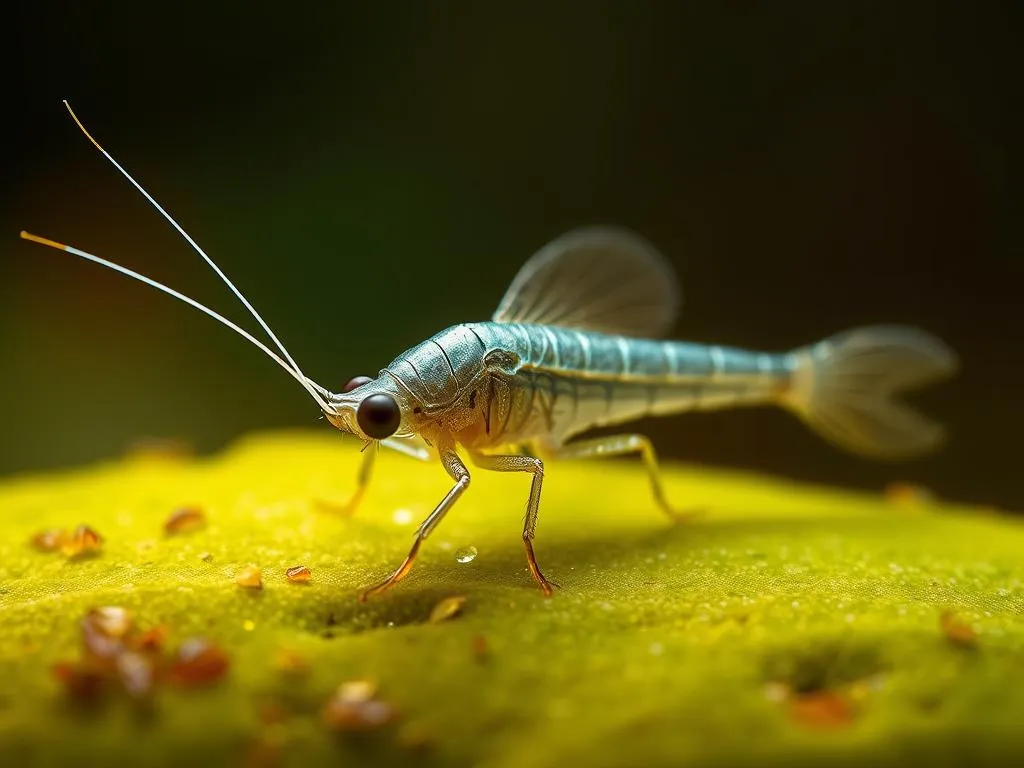Unraveling Silverfish Symbolism: The Hidden Meanings of this Ancient Insect

Disclaimer: Some images on this website are AI-generated artworks and may not accurately represent real animals.
Understanding Silverfish
Characteristics and Behavior
Silverfish, scientifically known as Lepisma saccharinum, are small, wingless insects characterized by their silvery-gray appearance and distinctive fish-like movements. Measuring about 1 to 2 inches in length, their elongated bodies are covered in fine scales, giving them a shiny appearance. Their three long, bristle-like tails and antennae contribute to their unique look, making them easily recognizable.
| Physical Characteristic | Description |
|---|---|
| Color | Silvery-gray |
| Size | 1 to 2 inches |
| Body Shape | Elongated and flat |
| Lifespan | Up to 3 years |
| Reproductive Mode | Oviparous (laying eggs) |
These insects are primarily nocturnal, preferring dark, humid environments such as basements, attics, and bathrooms. They feed on carbohydrates, specifically sugars and starches, which can be found in paper, glue, and even clothing. Their diet allows them to thrive in human habitats, often leading to frustrating infestations.
Silverfish have a lifespan of up to three years and reproduce by laying eggs in hidden crevices. The young nymphs resemble miniature adults, undergoing several molts before reaching maturity. This growth process is significant in understanding their symbolism, particularly in relation to change and transformation.
Cultural Significance
Throughout history, silverfish have made their mark in various cultures, often symbolizing different ideas and concepts. In ancient Egypt, they were associated with the preservation of knowledge, as they thrived in libraries and document-rich environments. Their presence often indicated ancient texts, scrolls, and manuscripts, tied to wisdom and the transmission of information.
Folklore surrounding silverfish often depicts them as harbingers of change. In some cultures, their appearance was thought to signify a transition or an impending transformation, aligning them with themes of metamorphosis and renewal. This historical presence adds depth to their symbolism and further enriches their meanings in contemporary contexts.

Symbolism & Spiritual Meaning
Adaptability and Resilience
One of the most compelling aspects of silverfish symbolism is their remarkable adaptability. These insects can thrive in a variety of environments, from damp basements to dry attics, showcasing their resilience. This ability to survive in diverse conditions makes them a powerful symbol of survival and resourcefulness.
In life, just as silverfish adapt to their surroundings, we too face challenges that require us to be flexible and resilient. The presence of silverfish in our lives can serve as a reminder to embrace change and adapt to new circumstances, encouraging us to develop the skills necessary to navigate life’s uncertainties.
Connection to Change and Transformation
The process of molting, where silverfish shed their old exoskeletons to grow, serves as a potent metaphor for personal transformation. This symbolism emphasizes the importance of letting go of outdated beliefs, habits, and past experiences to make way for new growth.
In many spiritual contexts, transformation is a vital aspect of personal development. Just as silverfish undergo physical changes, individuals are often encouraged to embrace their own journeys of growth. The act of shedding the old can lead to profound insights and renewed purpose, underscoring the connection between silverfish and the cyclical nature of life.
Secrets and Hidden Knowledge
Silverfish thrive in dark, concealed spaces, which has led to their association with secrets and hidden knowledge. In many cultures, they symbolize the uncovering of truths and the pursuit of wisdom. Their elusive nature can remind us of the importance of delving into the unknown, seeking out hidden aspects of ourselves, and striving for deeper understanding.
This symbolism encourages us to confront our fears, doubts, and uncertainties. Just as silverfish navigate dark corners, we too can explore the hidden depths of our psyche to uncover valuable insights and truths that may have been obscured.
Silverfish in Dreams
Common Interpretations
Dreams featuring silverfish can evoke a range of emotions and interpretations. Often, these dreams are associated with anxiety, fear of the unknown, or unresolved issues lurking beneath the surface. The presence of silverfish in dreams can symbolize feelings of discomfort or the need to confront hidden aspects of our lives.
Positive and Negative Connotations
The interpretation of silverfish in dreams can vary based on the context and the emotions experienced during the dream. Here are some common interpretations:
| Context | Positive Interpretation | Negative Interpretation |
|---|---|---|
| Dreaming of swarms | Abundance and resourcefulness | Overwhelm or chaos |
| Finding silverfish | Discovery of hidden talents | Encountering fears or doubts |
| Killing silverfish | Overcoming obstacles | Suppressing emotions |
| Observing silverfish | Gaining insight into dark areas | Anxiety about the unknown |
The messages conveyed through these dreams often reflect our subconscious thoughts and feelings, urging us to pay attention to the underlying issues that may need addressing.
Modern Interpretations
Symbol of Clutter and Neglect
In today’s fast-paced world, silverfish can symbolize clutter and neglect. Their presence in our homes may reflect life circumstances characterized by disorganization or emotional clutter. This symbolism serves as a call to action, urging us to evaluate our surroundings and address unresolved issues in our lives.
When silverfish appear, they may represent the need to declutter not only our physical spaces but also our emotional states. The act of organizing our lives can lead to a clearer mindset and a renewed sense of purpose.
Environmental Indicators
Beyond their role in our personal lives, silverfish can also serve as symbols of ecological balance and sustainability. They are indicators of environmental health, thriving in conditions that reflect a balanced ecosystem. Their presence can signal changes in the environment, prompting us to pay attention to our surroundings and the natural world.
Silverfish symbolism in this context encourages us to consider our impact on the environment and to cultivate sustainable practices in our daily lives. By recognizing the interconnectedness of all living things, we can strive for a more harmonious existence.
Key Takeaways
- Silverfish symbolism encompasses adaptability, resilience, and survival in challenging circumstances.
- The process of molting represents personal transformation and the importance of letting go of the old to embrace new growth.
- Their association with secrets and hidden knowledge encourages self-discovery and the pursuit of truth.
- Dreams featuring silverfish can reflect anxiety and unresolved issues, urging us to confront our fears.
- In modern contexts, silverfish symbolize clutter and neglect, prompting personal reflection and the need for organization.
- They also serve as indicators of environmental health, reminding us of our role in ecological sustainability.
Conclusion
In summary, silverfish embody resilience, transformation, and the pursuit of hidden knowledge. Their symbolism invites us to explore our personal connections with these ancient insects, encouraging us to reflect on our own journeys of growth and self-awareness. By understanding the meanings associated with silverfish, we can cultivate a deeper appreciation for the world around us and embrace the lessons hidden in the seemingly mundane aspects of life. As we observe our surroundings with renewed perspective, we may discover that even the most unassuming creatures can hold profound significance in our personal and collective narratives.







